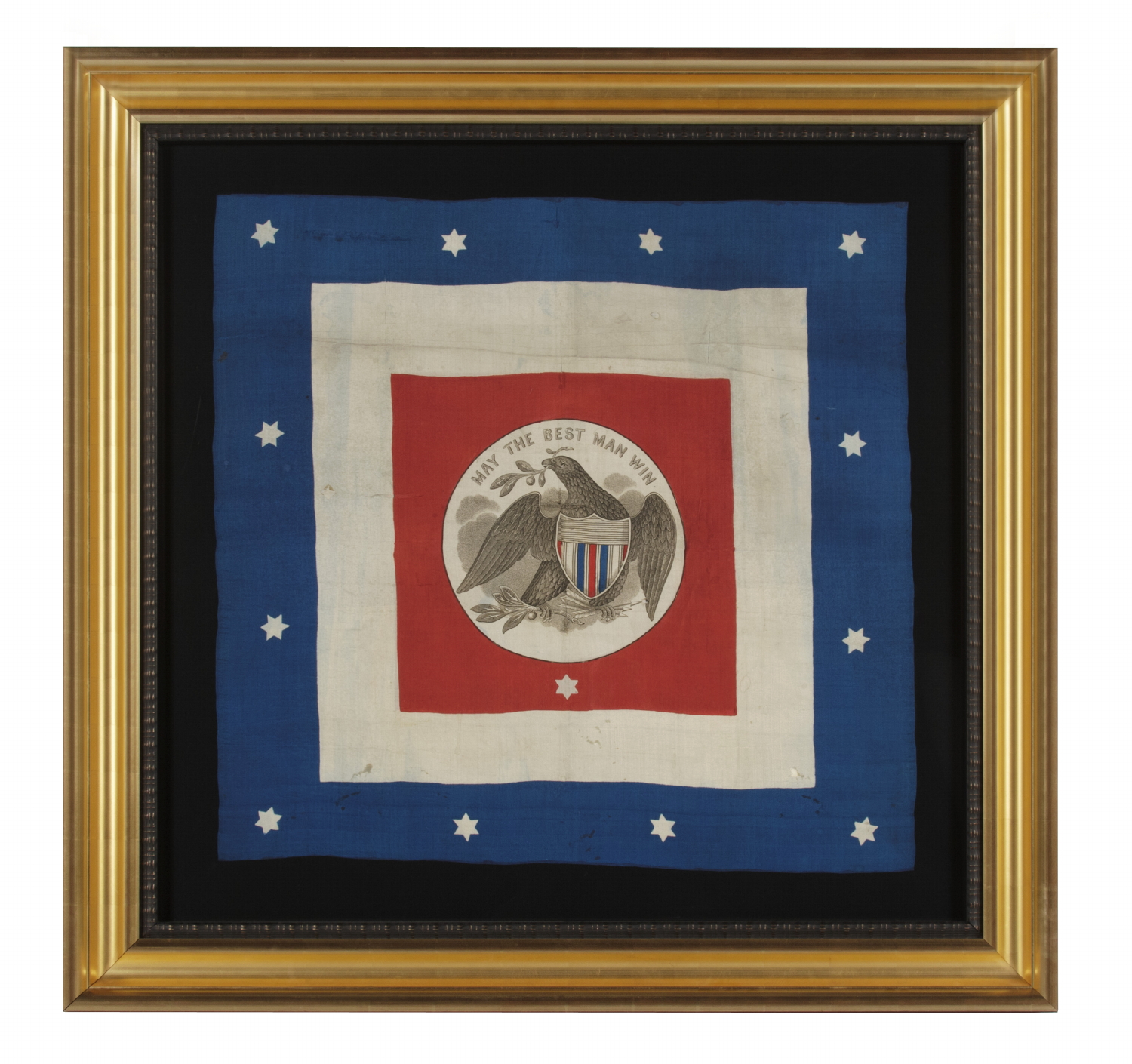
| |
RARE NON-PARTISAN POLITICAL KERCHIEF, MADE FOR A CAMPAIGN RALLY IN THE PERIOD BETWEEN 1852 AND 1860, WITH A DYNAMIC EAGLE THAT BECKONS FOR CONTINUED PEACE AND 13 SIX-POINTED STARS |
|
| Available: |
Sold |
| Frame Size (H x L): |
44" x 45.25" |
| Flag Size (H x L): |
31" x 32" |
|
| Description....: |
|
RARE NON-PARTISAN POLITICAL KERCHIEF, MADE FOR A CAMPAIGN RALLY IN THE PERIOD BETWEEN 1852 AND 1860, WITH A DYNAMIC EAGLE THAT BECKONS FOR CONTINUED PEACE AND 13 SIX-POINTED STARS:
Vibrant colors and an especially graphic design adorn this political campaign kerchief, printed on silk, which boasts the non-partisan slogan: "May the Best Man Win". The textile's splendid imagery includes concentric squares in vibrant red, white and blue surrounding a bold and interesting variation on the federal eagle, set within a circular center medallion. The eagle holds an olive branch in its right talon and a cluster of arrows in its left, and a second olive branch held firmly in its beak. Note how the eagle's head is facing to the right, towards the olive branch. This symbolism seems to hold both the message that the nation was currently at peace and that there was an offering of or a hope for continued peace. The large scale of the textile, the colors and the imagery all point to the Antebellum era, as the nation reluctantly poised for war. The bright, scarlet red suggests 1850's or after because red dyes used in 1840's silk kerchiefs typically achieve a brick red tone over time, whether or not they are exposed to light. The consensus of information therefore suggests that the kerchief probably dates to 1852 (Pierce vs. Scott), 1856 (Buchannan vs. Fremont and Fillmore), or 1860 (Lincoln vs. Douglas, Breckinridge, and Bell).
Note the use of 13 six-pointed stars that share their profile with the Star of David. This may indicate that the maker or designer of the kerchief was of Jewish faith, or it may simply be that the element was borrowed from some other device. Francis Hopkinson, signer of the Declaration of Independence and member of the Second Continental Congress, is widely accredited with being the man who designed the American national flag. A specialist in heraldry, he designed many things, such as the Great Seal of the United States and various colonial currencies. Some of Hopkinson's earliest illustrations include six-pointed stars. He is suspected of having designed the Seal of the Treasury Department [though the task was initially given to others] which bore six-pointed stars until 1968.
Whatever the case may be, the way in which the stars are incorporated, with 12 printed by way of relief in the blue border, evenly distributed, and the 13th in the same fashion in the bottom center of the red border, is likewise interesting. This is the only style of election-oriented political kerchief or flag of the 19th century that I have ever encountered that is multi-partisan and does not feature a particular candidate or party. Only two, including this one, are known to exist within the hobby of political and campaign textile collecting and they remain undocumented in any published text on the subject.
The combination of date, rarity, scale, excellent colors and graphics, plus the inclusion of fun and meaningful text with which a modern collector can identify, make this a masterpiece of mid-19th century American textiles.
Mounting: This is a sandwich mount between 100% cotton twill, black in color, and U.V. protective plexiglas. The black fabric was washed to reduce excess dye. An acid-free agent was added to the wash to further set the dye and the fabric was heat-treated for the same purpose. The mount was then placed in a substantial, gilded French molding with a classic American profile, to which a black liner with a rippled profile and gold highlights was added.
Condition: In the blue border there is a moderate separation along the top on the left side and a minor split with associated loss in the top center, accompanied by some tiny holes elsewhere and minor bleach spots. In the white and red borders there are minor splits and losses and minor soiling, accompanied by somewhat larger splits to the left and right of the medallion center. There is also some bleeding of the blue border into the white. In the eagle medallion there are moderate splits both vertical and horizontal from fold lines, thankfully with only very minor loss. Where needed, the underlay was painted to better match the fabric around it. The colors are remarkably strong and vibrant. The great rarity and presentation, as well as the early date, well-warrants the condition. |
|
|
|
| Collector Level: |
Flags for the truest Patriots. My best offerings |
|
| Flag Type: |
|
|
| Star Count: |
13 |
|
| Earliest Date of Origin: |
1852 |
|
| Latest Date of Origin: |
1860 |
|
| State/Affiliation: |
13 Original Colonies |
|
| War Association: |
1777-1860 Pre-Civil War |
|
| Price: |
SOLD |
|
| |
Views: 2640 |
|
|
|

